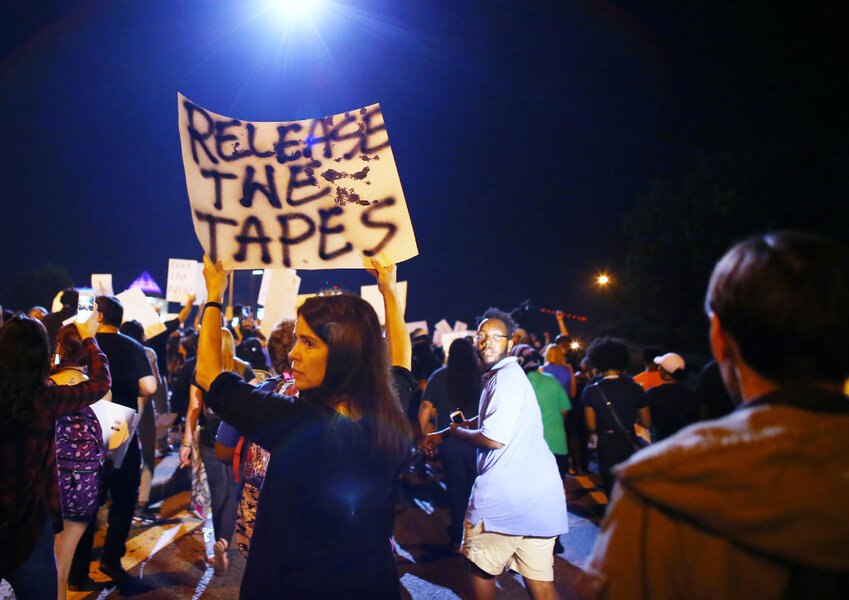Will North Carolina's new video law bring more, or less, transparency?
Loading...
Protestors at Charlotte may see an additional hurdle in their bid for police to release the video of Keith Lamont Scott’s fatal shooting as a new law comes into effect on Oct. 1.
The controversial law, signed by Republican Gov. Pat McCrory in July, will exclude police body and dashboard cameras from public records and only allow people involved in the footage to review it – with the police’s discretion. For others, a court order is required.
“Technology like dashboard and body cameras can be very helpful, but when used by itself, technology can also mislead and misinform, which also causes other issues and problems within our community,” Governor McCrory said, as reported by The News and Observer. “What we need to do is walk that fine line.”
McCrory’s aims were to protect the integrity of an investigation while also increasing public trust. But will the new law achieve that balance - or will it hamper efforts for greater police accountability?
To some, especially organizations advocating for transparency, lengthening the process for video access only serves to reduce trust between the police and the community.
“People who are filmed by police body cameras should not have to spend time and money to go to court in order to see that footage,” Susanna Birdsong, policy counsel for the ACLU of North Carolina, said in a press release. “These barriers are significant and we expect them to drastically reduce any potential this technology had to make law enforcement more accountable to community members.”
Michael Rich, a professor of law at Elon University, pointed out in a column in May that giving the police so much power in deciding who can watch the videos is a conflict of interest.
“If police have done something wrong, how can the top cop be expected to make the right decision about releasing the footage?” Professor Rich wrote when law was still a bill. “The bill requires him to balance concerns like the “public interest,” people’s reputation and privacy, and state and federal disclosure laws. But police chiefs aren’t experts on the public interest or federal disclosure laws and can’t be expected to find the right balance of these issues.”
The addition of a judge, however, may in some instances insert neutrality into the process that leads to further transparency. It has precedence in other states, the most prominent being the case late last year in Chicago where Laquan McDonald, an African-American teenager, was shot to death by a police officer.
The judge had ordered for the release of the video showing the incident despite resistance from the police, and it eventually led to the the officer who shot McDonald being charged with murder, appointment of a new police superintendent, and swifter response in cases of police who use excessive force.
In 2015, another judge in California ordered the city of Gardena, a Los Angeles suburb, to release the police video of a fatal shooting of an unarmed man.
Both videos were released after journalists challenged officials for access. The Chicago case took the freelance journalist months of effort to succeed. Going through the court to demand access, like Birdsong said, will require resources and time.
“To have people go to court, it’s way too time-consuming and expensive to really solve this problem in Charlotte,” Professor Rich tells The Christian Science Monitor in a phone interview. “It will take too long for the issue to be adjudicated.”
Rich says the decision should be best left with those who are most used to dealing with public information requests - those whose job has always been to decide what materials should be redacted and what can be released by government departments that oversee public records.
“We should just treat these stuff like other public records,” Rich says. “Yes, eventually that process can find it’s way into the court, but it’s nice to have that process folks can follow before going to court.”
Rich’s suggestion echoes a decision by Washington, D.C., last year to open most of its police body camera footage to the public, accessible through Freedom of Information Act (FOIA) requests, which is the typical procedure for requesting public records.
The District of Colombia did take the step of giving the elected mayor final say on whether the videos can be released if the FOIA is not granted or restricted. It has been credited in speeding up the process: In July, under Mayor Muriel Bowser’s order, footage of police fatally shooting a man holding a pellet gun was released in less than a month after the incident.
[Editor's note: The original story incorrectly stated the legal situation for the Chicago police officer who shot Laquan McDonald. He's been charged with murder.]






